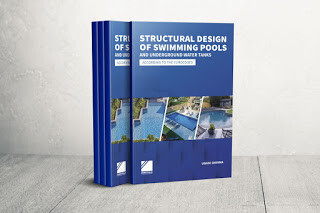I spent a large part of the last few months developing the contents of this booklet on ‘Structural Design of Swimming Pools and Underground Water Tanks (According to the Eurocodes)’. Water is necessary for survival of mankind, but in one way or another, water is relatively scarce. We all know that rain does not fall continuously, and for water to be available for usage in homes, it will have to be fetched/pumped from the stream, or harvested during rainfall, or dug up from the ground. As a result, survival instincts made man to create different means of storing water in order to face the periods of scarcity.
One of the alternatives of storing water is the use of reinforced concrete structures which may be buried under the ground, supported on the ground surface, or elevated above the ground surface. Civil engineers have been at the forefront of designing these infrastructures in order to meet accepted performance criteria. One of the profound requirements of water tanks is water tightness, which can be related to the serviceability limit state requirement of cracking, amongst other factors.
The publication highlighted above focuses on the use of reinforced concrete for construction of underground water tanks and swimming pools. All the factors usually considered in the design of underground water retaining structures such as geotechnical analysis, modelling, loading, structural analysis, and structural design were all presented in an objective manner to the reader. Also, the use of Staad Pro Software was explored in detail on how it can be used to model and analyse tanks and swimming pools.
I am going to use the screenshots below to show you some of the contents, with hope that you will find it interesting. The images are arranged in no specific order.
The publication also paid serious attention to how water tightness can achieved on site through careful and standard construction practices. In addition to this 167 pages booklet, I also developed excel spreadsheets that can help make calculation of crackwidths faster, and Staad Pro video tutorials, peradventure you want to master the use of the software. Kindly see screenshot below;
For this reason, there are three different packages that can be purchased to match different levels of interest in the content.












Good work always pay. More wisdom to you sir. Thank you .
Good work .I really appreciate your work. Kindly keep it up. I will advise you get it published. I till go along way to add more knowledge to student as well. Most books in PDF are often not read. But if it is in hard copy it can easily be referenced.
If you model cylindrical pools or tanks, the most important strees/forcé is Sx or Sy, the horizontal one.
Very interesting post. Thank you for sharing
God work. Please keep doing the great work.
You really tried. Keep doing it. Thanks
so helpful
so useful
We appreciate the good work guys keep it up
This is amazing
Please who can help me with Orion software installation and cracking.
I need it, I will pay.
Reach me 09064148908
Thanks
Sir, why not BS codes.
The BS codes you are familiar with have been withdrawn
How can i buy that book?
Hi Engr. Ubani,
Can I avail you book?
what is the effect of wall base shear on the design of base slabs? I believe that this shear will be reflected as axial tension on the base slab. moreover, what is the effect of friction between base slab and soil on the distribution of axial tension?
Thanks for the explaining that reinforced concrete is often used for pool designs. I’d like to know more about that because I’ve been thinking about getting one built in my property soon. Getting it done by the spring would be nice just in time for the weather to warm up.
I was captured when you discussed that the use of reinforced concrete structures is a good alternative for storing water. My friend wants to install a pool reinforcing steel. I should advise him to hire an expert in pool reinforcing steel installation to ensure quality work.